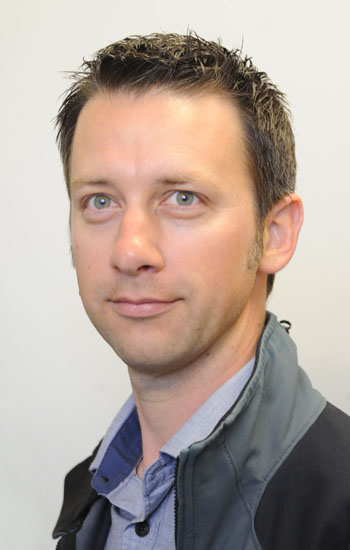Dr Martin Austin
Senior Lecturer in Ocean Sciences

Links
- https://www.researchgate.net/profile/Martin_Austin
Researchgate
Contact info
Office: 211 Marine Centre Wales Phone: 01248 382803
Email: m.austin@bangor.ac.uk
Web: Google Scholar ResearchGate ORCID
Twitter: @mart_austin
I am an observational oceanographer and specialise in the hydro- and morpho-dynamics of the inter-tidal and shallow sub-tidal regions of the coastal ocean. My present research at Bangor includes:
- Increasing our understanding of gravel barrier dynamics and resilience in a changing climate. Through the NERC-funded project #gravelbeach, it will deliver new scientific advances through an integrated and comprehensive morphosedimentary evaluation, intense field observations, targeted laboratory experiments, and numerical model development/simulation. This research involves UK-wide collaboration with multiple academic and industry partners.
- The turbulent flow dynamics around offshore infrastructure and sub-sea cables that result in changes to the seabed habitat, the vertical mixing of heat and nutrients through the water column and physical impacts to the infrastructure. This research is funded through NERC and ESPRC projects and involves significant collaboration with industry partners from the Marine Renewable Energy sector.
- The dynamics of large-scale turbulent motions in tidally energetic regions. This EPSRC- and NRN-funded work seeks to quantify large-scale turbulent motions and assess the impacts on tidal energy extraction and infrastructure. Observational field experiments are being undertaken in the Menai Strait and around north Wales, and include industry collaborators from UK, Europe and the USA.
I graduated from Plymouth University in 2002 with a BSc in Ocean Science and completed my PhD in gravel beach morphodynamics at Loughborough University in 2005. I have subsequently been a Post-doctoral Research Fellow at: Plymouth University (2005 - 2007, Cross-shore sediment transport on sandy beaches); Loughborough University (2007, Dust generation on an Arctic pro-glacial flood plain); before returning once again to Plymouth (2007 - 2010, Impacts of offshore wave energy arrays on seabed and shoreline processes; and 2010 - 2013, Dynamics of rip currents and implication for beach safety). Research Areas
Contact Info
Office: 211 Marine Centre Wales Phone: 01248 382803
Email: m.austin@bangor.ac.uk
Web: Google Scholar ResearchGate ORCID
Twitter: @mart_austin
I am an observational oceanographer and specialise in the hydro- and morpho-dynamics of the inter-tidal and shallow sub-tidal regions of the coastal ocean. My present research at Bangor includes:
- Increasing our understanding of gravel barrier dynamics and resilience in a changing climate. Through the NERC-funded project #gravelbeach, it will deliver new scientific advances through an integrated and comprehensive morphosedimentary evaluation, intense field observations, targeted laboratory experiments, and numerical model development/simulation. This research involves UK-wide collaboration with multiple academic and industry partners.
- The turbulent flow dynamics around offshore infrastructure and sub-sea cables that result in changes to the seabed habitat, the vertical mixing of heat and nutrients through the water column and physical impacts to the infrastructure. This research is funded through NERC and ESPRC projects and involves significant collaboration with industry partners from the Marine Renewable Energy sector.
- The dynamics of large-scale turbulent motions in tidally energetic regions. This EPSRC- and NRN-funded work seeks to quantify large-scale turbulent motions and assess the impacts on tidal energy extraction and infrastructure. Observational field experiments are being undertaken in the Menai Strait and around north Wales, and include industry collaborators from UK, Europe and the USA.
I graduated from Plymouth University in 2002 with a BSc in Ocean Science and completed my PhD in gravel beach morphodynamics at Loughborough University in 2005. I have subsequently been a Post-doctoral Research Fellow at: Plymouth University (2005 - 2007, Cross-shore sediment transport on sandy beaches); Loughborough University (2007, Dust generation on an Arctic pro-glacial flood plain); before returning once again to Plymouth (2007 - 2010, Impacts of offshore wave energy arrays on seabed and shoreline processes; and 2010 - 2013, Dynamics of rip currents and implication for beach safety). Research Areas
Grant Awards and Projects
-
Cable Scour from fluid-seabed interactions in regions of mobile sedimentary bedforms
Engineering and Physical Sciences Research Council
-
Measurable metrics for characterisation of large-scale turbulent structures in tidal races for the marine tidal energy industry
Engineering and Physical Sciences Research Council -
Waves Across Shore Platforms
Engineering and Physical Sciences Research Council -
BU-IIA Tidal Cut off with RNLI S28904
Teaching and Supervision
PhD Students
- Guy Walker-Springett
- Natasha Lucas
- Alex Virod
Masters Teaching
I offer both MSc and MSci research projects on shallow water physical oceanography and sediment dynamics processes, and contribute to several taught MSc modules.
Undergraduate Teaching
I am the progarmme organiser for the BSC Geological Oceanography degree and am the module organiser for OSX-3006 and OSX-3007, and contribute to OSX-1000, OSX-2000, OSX-2004, OSX-2006, DXX-2007, OSX-3000, DXX-3018 and OSX-4023.
Postgraduate Project Opportunities
Project 1:
I am keen to develop a PhD project with a student to investigate the sediment resuspension and scour that occurs when sub-sea cables are exposed by bedform migration on the energetic continental shelf.
It is hypothesised that wake effects from emplaced objects on the seabed modify bedform migration rates through increased turbulent velocities and lead to a higher incidence of cable damage.
This project links with the Marine Renewable Energy industry and at the finer scale aims to take field measurements of turbulent flows and sediment suspension over a section of free-spanning sub-sea cable.
Wider-scale observations will aim to link far-field changes in bedform migration (and hence cable exposure) rates to wake effects of emplaced objects.
Postgraduate Project Opportunities
Project 2:
I am interested in developing a PhD project with a potential student to investigate the coupling between the sub-tidal and inter-tidal sections of the beachface and a dynamic aeolian sand dune field.
It is hypothesised that over-stabilised sand dunes minimise the exchange of sand between dunes and beachface, and combined with storm-driven offshore sand transport, result in a lowering the beach elevation and enhanced wave energy flux impacting the dune foot.
Long-term large-scale dyanmics of an extensive offshore sandbank system appear to exert a significant alongshore control on the wave impacts experienced by the dune foot.
This project is based in North Wales and could potentially collaborate with National Resources Wales.
Education / academic qualifications
- PhD , Swash-groundwater interactions on a natural gravel beach
- BSc , Ocean Sciences
Research outputs (48)
- E-pub ahead of print
Cut off by the tide: How Ocean Literacy can help save lives
Research output: Contribution to journal › Article › peer-review
- Published
Tidal literacy: Public understanding and misconceptions of the tide
Research output: Book/Report › Other report
- Published
Enhanced bed shear stress and mixing in the tidal wake of an offshore wind turbine monopile
Research output: Contribution to journal › Article › peer-review
Prof. activities and awards (14)
National Trust meeting - Porthdillaen flooding & community
Activity: Other › Types of Public engagement and outreach - Work on advisory panels for social community and cultural engagement
Nortek - SOS meeting: future instruments and collaboration
Activity: Other › Types of Business and Community - Hosting of external, non-academic visitor
RNLI NW Region Annual Water Safety Workshop
Activity: Participating in or organising an event › Participation in Academic workshop, seminar, course
Projects (7)
Gravel barrier resilience in a changing climate (#gravelbeach)
Project: Research
Media coverage (1)
Extensive press coverage of public understanding of the tide
Press/Media: Research

